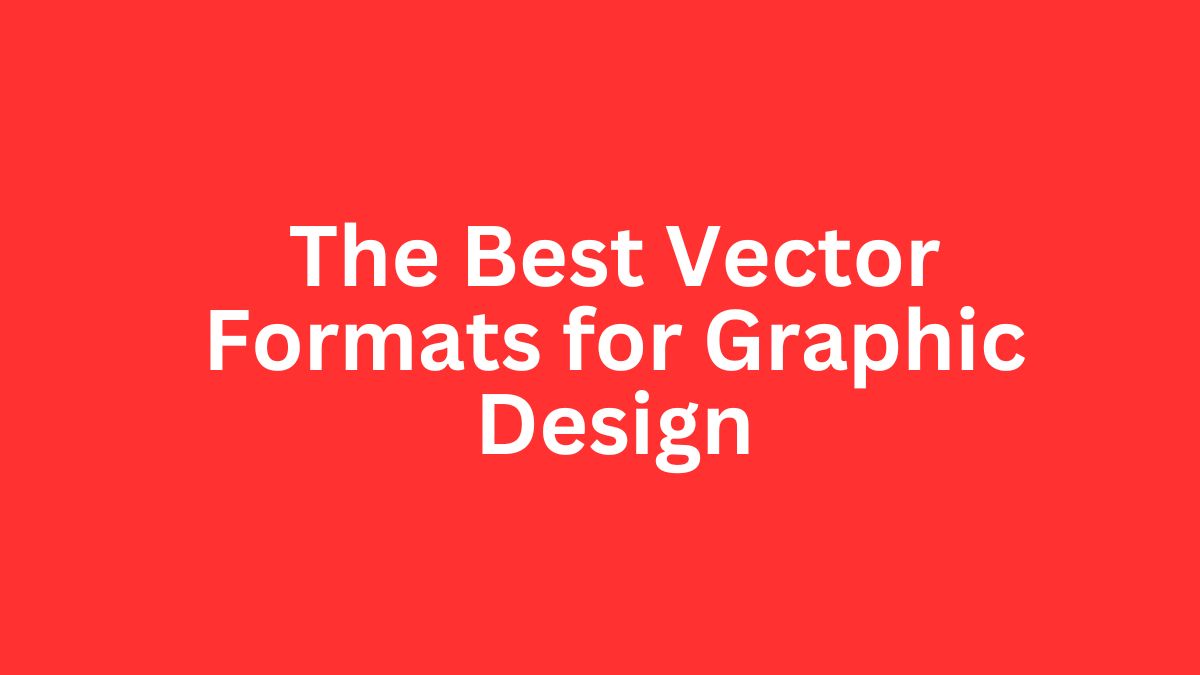
In the world of graphic design, vector formats play a crucial role due to their scalability, precision, and flexibility. Unlike raster images, which are made up of pixels and can lose quality when scaled, vector graphics are composed of mathematical equations that define shapes, lines, and colors. This makes them ideal for logos, illustrations, and any design that requires resizing without loss of quality. This blog post will delve into the best vector formats for graphic design, exploring their unique features, benefits, and use cases.
Understanding Vector Graphics
Before we dive into specific formats, let’s clarify what vector graphics are and why they are essential in graphic design. Vector graphics use paths, defined by a start and end point, along with other points, curves, and angles, to create images. These paths can be scaled infinitely without any loss of quality, making vector graphics incredibly versatile for various design applications.
Key advantages of vector graphics include:
- Scalability: Vector graphics can be resized to any dimension without losing clarity or detail.
- Editability: They are easily editable, allowing designers to tweak shapes, colors, and sizes effortlessly.
- File Size: Vector files are typically smaller than raster files, making them easier to share and store.
Now, let’s explore the best vector formats commonly used in graphic design.
1. SVG (Scalable Vector Graphics)
Overview: SVG is an XML-based format developed by the World Wide Web Consortium (W3C) for describing two-dimensional vector graphics. It supports interactivity and animation, making it a versatile choice for web and graphic design.
Advantages:
- Scalability: SVG files can be scaled to any size without losing quality, making them perfect for responsive web design.
- Editability: They can be edited with any text editor and most graphic design software.
- Interactivity: SVG supports scripting and CSS, allowing for interactive and animated graphics.
Use Cases:
- Web graphics
- Icons
- Infographics
- Logos
Example: A website logo that needs to be displayed on different devices with varying screen sizes can benefit from being an SVG file. This ensures it remains sharp and clear on all screens.
2. AI (Adobe Illustrator)
Overview: AI is a proprietary vector format developed by Adobe Systems. It is the native format for Adobe Illustrator, one of the most widely used vector graphic design programs.
Advantages:
- Compatibility: AI files are fully compatible with other Adobe Creative Cloud applications, allowing seamless integration across different design workflows.
- Feature-Rich: Adobe Illustrator offers extensive tools for creating complex vector artwork.
- Editability: AI files retain editability within Illustrator, enabling designers to make precise adjustments to their designs.
Use Cases:
- Detailed illustrations
- Complex logo designs
- Print media
Example: A detailed illustration for a magazine cover can be created and refined using the AI format, leveraging Illustrator’s robust tools and features.
3. EPS (Encapsulated PostScript)
Overview: EPS is a vector format that can contain both vector and raster elements. It was developed by Adobe and is widely used for printing and publishing purposes.
Advantages:
- Versatility: EPS files can be opened and edited in various graphic design programs, not just Adobe products.
- Print-Ready: They are well-suited for high-resolution printing, making them a staple in the publishing industry.
- Compatibility: EPS is a widely accepted format across different platforms and software.
Use Cases:
- Print design
- Logos
- Brochures and flyers
Example: A company’s logo designed in EPS format can be sent to different vendors for printing on business cards, letterheads, and promotional materials, ensuring consistent quality.
4. PDF (Portable Document Format)
Overview: While PDF is commonly known as a document format, it can also support vector graphics. Developed by Adobe, PDF is versatile and widely used for sharing and printing documents and graphics.
Advantages:
- Universal Compatibility: PDF files can be opened on virtually any device with a PDF reader, ensuring wide accessibility.
- Preservation: PDFs maintain the integrity of the design, including fonts and images, across different platforms.
- Interactivity: PDFs can include interactive elements like hyperlinks and form fields.
Use Cases:
- Printable documents
- Interactive forms
- Marketing materials
Example: A PDF brochure designed with vector graphics ensures that all images and text remain crisp and clear when printed or viewed on different devices.
5. CDR (CorelDRAW)
Overview: CDR is the native vector format for CorelDRAW, a popular graphic design software. It is widely used for various design projects, especially in regions where CorelDRAW is prevalent.
Advantages:
- Feature-Rich: CorelDRAW offers powerful tools for creating and editing vector graphics.
- Editability: CDR files are easily editable within CorelDRAW, allowing for detailed modifications.
- Compatibility: CorelDRAW can import and export other popular vector formats, providing flexibility in design workflows.
Use Cases:
- Detailed illustrations
- Logo design
- Signage
Example: A detailed vector illustration for a billboard can be created in CDR format, taking advantage of CorelDRAW’s advanced design features.
Choosing the Right Vector Format
When selecting a vector format for your graphic design projects, consider the following factors:
- Project Requirements: The type of project (web, print, interactive) will influence your choice of vector format.
- Software Compatibility: Ensure the format is compatible with the design software you are using.
- Editability: Choose a format that allows for easy editing if you anticipate making changes to the design.
- End Use: Consider how the final design will be used and shared, whether for web display, printing, or distribution.
Conclusion
Vector formats are indispensable in graphic design, offering scalability, precision, and flexibility. Each format has unique advantages and use cases. They suit different projects. SVG is ideal for web graphics, AI is perfect for detailed illustrations, EPS excels in print design, PDF is versatile for documents and marketing materials, and CDR is powerful for detailed vector artwork.
By understanding the strengths of each vector format, you can choose the best one for your specific needs, ensuring high-quality, professional designs that look great at any size.